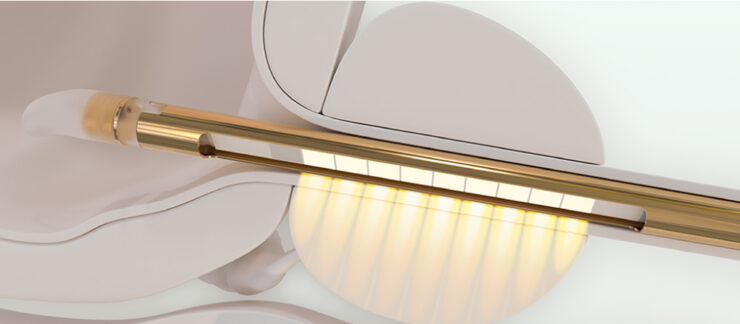The University Hospital of Cologne is one of the largest in Germany with 59 departments and institutions, and is a leading interdisciplinary Oncology Center of Excellence. Recently, the interdisciplinary uro-oncology section of the University Hospital was certified as a national and European Cancer Centre of Excellence. University Hospital of Cologne is internationally recognized as an important research center, developer of new treatment methods, and active driver of medical innovation, providing treatment to more than 300,000 patients annually, with 60,000 of them receiving inpatient care. It is also the first adopter of Profound Medical’s (NASDAQ:PROF) two novel technologies of high intensity focused ultrasound (HIFU) therapy: TULSA-PRO for customized incision-free focal and whole-gland ablation of the prostate using transurethral thermal ultrasound and real-time MRI imaging to protect surrounding tissue, and Sonalleve, a CE Marked platform also combining HIFU and real-time MRI thermometry for precise and incision-free ablation of tissue from outside the body, such as uterine fibroids and bone tumors. For this article, BioTuesdays interviewed four researchers at University Hospital of Cologne about the hospital’s modern personalized treatment of patients with TULSA-PRO and Sonalleve.
PD Dr. Thorsten Persigehl
department of radiology
Prof. David Maintz
director of the radiology department
Prof. Holger Grüll
experimental imaging and image-guided therapy department
Prof. Axel Heidenreich
director of the department of urology, uro-oncology and robot-assisted surgery
What are the origins of HIFU treatment at your hospital?
Prof. Maintz: When I came to the University Hospital of Cologne, I had the opportunity to acquire some new imaging hardware and HIFU became an attractive therapy to treat new indications inside the body without open surgery. We began using HIFU in 2015 to treat uterine myomas and still use it to treat uterine fibroids and certain benign and malignant bone tumors and soft tissue indications.
[Editor’s note: Profound Medical’s Sonalleve uses HIFU to offer incision-free alternatives to traditional surgical treatments of uterine fibroids, which are non-cancerous growths in the uterus. The treatment happens while a patient is inside an MRI scanner, which monitors the targeted fibroid, while an ultrasound transducer delivers focused sound waves into the fibroid. Sonalleve, which is approved in Europe, most of Asia, the Middle East and South America, also has been adopted for pain associated with bone metastases.]
How is MRI and TULSA-PRO a central point for prostate disease management?
Prof. Heidenreich: MRI is now a modern approach for diagnosis of prostate cancer, providing specific answers to specific questions about organ-confined and advanced disease. MRI also gives us a picture of the extent and location of the disease and triggers the type of treatment we use best for prostate cancer. MRI/ultrasound-fused biopsy has become the standard of care for prostate cancer in Europe and transrectal ultrasound-guided biopsy should not be performed any more.
[Editor’s note: Profound Medical’s TULSA-PRO is the only device to merge three modalities – real-time magnetic resonance imaging, direct and controlled thermal ultrasound and close-loop temperature feedback – into a customized, incision-free transurethral ablation of prostate tissue while actively protecting the urethra and rectum to help preserve a patient’s natural functional abilities. The TULSA-PRO procedure was approved in Europe in 2016 and by the FDA in 2019.]
How did Cologne become a center of excellence for TULSA-PRO and Sonalleve?
Dr. Grüll: At our hospital, we have a clinical system for Sonalleve available for patient treatments that falls within the CE label and also for compassionate use cases. We are also fortunate to have a dedicated research group on new MR-HIFU applications, comprising a multidisciplinary team of physicists, chemists, biomedical engineers and medical doctors working on HIFU for the past 15 years. Most importantly, we have a MR-HIFU research system available entirely dedicated to technical and preclinical research. The latter allows rapid translation of technical innovation into clinical practice, such as first-in-man clinical trials for treatment of facet joint arthritis and pancreatic cancer. Together with Profound Medical, we have two large public-private partnerships funded by the German government to jointly develop the Sonalleve technology for the above applications. The close collaboration on the technical side together with the early clinical translation of new treatments is very beneficial and of mutual interest, as Cologne can serve as a test bay for prototypes and new applications.
Are there benefits to offer both of Profound’s technologies?
Dr. Grüll: The key to the Profound technology is the integration of the TULSA transducer and the Sonalleve HIFU transducer within the MR environment. The MRI provides high contrast anatomical images for treatment planning, and, importantly, provides near-real time temperature maps during the therapy. The closed-feedback between the MR thermometry and the power output of the ultrasound transducer is a unique point of the Profound technology. The integrated feedback allows to reach well- defined temperatures or to deliver a well-defined thermal dose, which is a key requisite to ensure lethal damage to tumor tissue.
What are your next research plans and clinical steps?
Dr. Grüll: Our aim is to take the Sonalleve system into clinical trials beginning early 2021 for the treatment of pancreatic cancer and facet joint arthritis.
When did your hospital adopt TULSA-PRO?
Dr. Persigehl: We began using TULSA-PRO in 2017 when we were part of Profound Medical’s international pivotal TACT trial. We were one-of-two centers in Germany and one-of-five centers in Europe that participated in the trial. Now, we routinely treat national and international patients with localized prostate cancer at our Center of Excellence for HIFU.
Can you comment on the significance of the TACT trial results?
Dr. Persigehl: The TACT trial results were very important because they demonstrated very low complications rates and promising outcome data in a clinical setting. These data are important for patients to compare TULSA with the established surgical and radiation therapy options so they can better decide what kind of treatment they prefer, especially in respect of complication rates. In addition, the TACT data were very important for us in discussions with health insurance companies to get the treatment paid for, and we wanted health insurance companies to see what the benefits of TULSA are.
What types of prostate cancer patients are best suited for treatment with TULSA-PRO?
Prof. Heidenreich: Prostate cancer staging is based on biopsy results, including Gleason score, PSA levels and the findings of a pre-biopsy multiparametric MRI of the prostate. The lowest Gleason score is 6, which is a low-grade cancer. A Gleason score of 7 suggests medium-grade cancer, and a score of 8, 9, or 10 is a high-grade cancer. Patients with low-risk and favorable intermediate prostate cancer are counselled to undergo treatment with TULSA as an experimental alternative to active surveillance, nerve sparing robot-assisted radical prostatectomy and the various options of radiation therapy. About 30% of patients with low-risk prostate cancer prefer active surveillance. Good candidates for TULSA include patients with organ-confined prostate cancer and no unfavorable pathohistologic findings, such as lymphovascular invasion, perineural invasion, cribriform growth pattern and extraprostatic extension.
Can you summarize clinical benefits you’ve seen with TULSA and patient feedback?
Dr. Persigehl: So far, we have seen extremely low complication rates, including incontinence, which is a favorable outcome for patients. There is a slight initial decrease of erectile function, but this recovers during the first six-to-12 months after treatment. Moreover, we are keeping patients after prostate treatment in hospital only overnight and they can leave the next day without physical limitations. Maybe if we could slightly reduce anesthesia, TULSA might be performed as an outpatient procedure in the future.
• • • • •
To connect with Profound or any of the other companies featured on BioTuesdays, send us an email at editor@biotuesdays.com.







